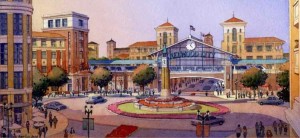It’s a common complaint among infill developers that there’s not enough public support for basic infrastructure upgrades in some of the most transit-friendly neighborhoods. So instead of the community helping to pay for upgraded sewer, power, and water lines, not to mention parks and sidewalks, it often falls to the first developer out of the gate to bear those costs.
This lack of public support has been the norm since redevelopment agencies committed suicide in the California Supreme Court back in 2011, forcing them to be dissolved to save the state some money. These agencies used to have authority to dedicate future increases in local tax revenue to pay back upfront investments in the neighborhoods that would spur economic growth.
I blogged about this situation a few weeks ago, with a write-up of a bill on the governor’s desk to use infrastructure finance districts as a redevelopment substitute. Some political observers fear this new mechanism because it has no limits on where it can be implemented, possibly leading to more infrastructure and investment in sprawl areas.
But there’s a competing measure on the governor’s desk that is more focused on resurrecting redevelopment for low-income areas. AB 2280 (Alejo) would only allow redeveloment to come back in these areas, with a strong focus on allowing developers to build more affordable housing and generate more economic development in these communities. Proponents argue that it’s much more limited in scope than the old redevelopment mechanism and won’t cost the state any money.
AB 2280 could certainly provide a more focused retooling of redevelopment, but it carries the risk of causing more gentrification and not necessarily building more transit-friendly neighborhoods to reduce traffic and air pollution. In fact, the bill has no environmental criteria that I can see, such as limiting application to neighborhoods that are transit-rich or in which more development would help the state meet its environmental goals. Still, lower-income neighborhoods often see higher transit ridership, so AB 2280 could end up being a safe bet for smart growth.
Overall, it’s encouraging to see some new momentum to rebuilding financing mechanisms that could benefit infill infrastructure. But I wish the existing options had stronger environmental criteria to allow the rebirth of redevelopment only in infill areas around the state. Those are the neighborhoods in which we should invest our scarce public resources — not in outlying areas that generate more traffic and pollution.



